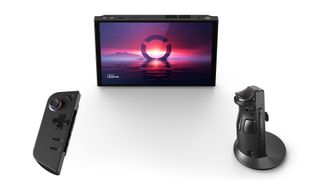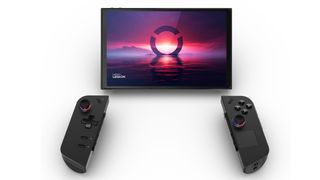Lenovo Legion Go is the powerhouse that the handheld gaming market has been missing
First it was the Steam Deck, then we had the Asus ROG Ally, and now Lenovo is jumping into the fray as the company has officially unveiled its new portable gaming device: the Legion Go.
Perhaps the most eye-catching aspect of all that the Lenovo Legion Go has to offer is its detachable TrueStrike controllers. Like the Nintendo Switch Joy-Cons, they feature two joysticks, a directional pad, and a variety of face buttons. Pretty standard stuff.
But that’s where the similarities end, because these TrueStrike controllers can do so much more. In total you have 10 – yes, 10 – assignable shoulder buttons: two triggers, two bumpers, four on the back (two on each controller), plus an extra pair of inputs on the edges.
If that wasn’t enough, the right controller has a trackpad on the front for controlling an on-screen cursor, while a mouse wheel sits on the back for scrolling. There is an optical “eye” on the underside of the controller. When the “eye” is placed in the accompanying stand, the peripheral can serve as a rudimentary gaming mouse.
Needless to say, the Legion TrueStrike controllers on the Legion Go completely blow the Switch’s Joy-Cons out of the water. It even comes with RGB lighting around the power button. Not only that, Lenovo’s hardware features “hall-effect joysticks,” meaning there’s no frustrating controller drift that you might experience on the Switch.
Notable features
In addition to the controllers, the Legion Go of course has more to offer.
The screen is 8.8 inches Lenovo PureSight gaming touchscreen, according to the company. With an aspect ratio of 16:10, it delivers a Quad HD Plus resolution (2560 x 1600 pixels) with a refresh rate of up to 144 Hz. The screen is “capable of a brightness of up to 500 nits” and covers “97 percent (of the) DCI-P3 color gamut”. Essentially, the screen looks fantastic.
Under the hood you have an “AMD Ryzen Z1 Extreme processor” alongside an AMD RDNA graphics card, the exact same type of hardware found on the ROG Ally. It also has 16 GB of LPDDR5X RAM on board. So if you’ve tried out the ROG Ally, you can expect a similar level of performance on the Legion Go.
The storage peaks at 1TB, although you can expand it by a further 2TB via a micro-SD card.
With all this hardware, the Legion Go will be quite power hungry. Lenovo equips its handheld with a 49.2 Wh (watt hour) battery. It supports the company’s own Super Rapid Charge technology, which can charge the battery up to 70 percent in about 30 minutes.
Other notable features include power bypass mode to “protect the battery from (deterioration)” and a kickstand on the back to prop up the Legion Go.
Availability
Color us impressed. Lenovo is entering the handheld firearms scene. Neither the Steam Deck nor Ally have opted for detachable controllers. We’re curious if Lenovo plans to release the TrueStrike itself, so we asked. This story will be updated if we hear anything.
The Lenovo Legion Go launches on October 31 with prices starting at £699/€799. That’s about $875 USD, making it more expensive than both the Steam Deck and ROG Ally.
If you’re looking for something to play on your newly purchased Legion Go, check out TechRadar’s list of the best steam games for 2023.


